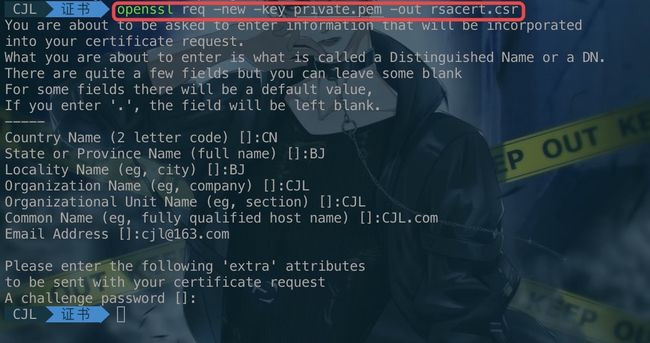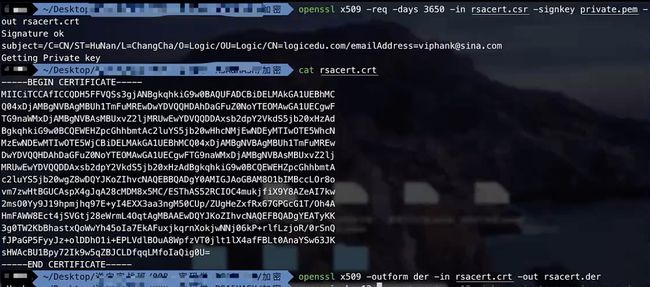iOS 底层原理 + 逆向 文章汇总
本文主要介绍RSA的代码演示过程
RSA代码演示
前提:准备好公钥、私钥,需要在终端生成(属于自己签名)
证书申请步骤
1、申请
CSR文件:keychain -> 证书助理 -> 从证书颁发机构请求证书-
2、生成
CSR请求文件(证书颁发机构信息 + 公钥)- 命令:
openssl req -new -key private.pem -out rsacert.csr
- 命令:
-
3、生成
CRT证书(自己签名,没有认证的)- 命令:
openssl x509 -req -days 3650 -in rsacert.csr -signkey private.pem -out rsacert.crt
- 命令:
-
4、生成der文件
- 命令:
openssl x509 -outform der -in rsacert.crt -out rsacert.der
- 命令:
-
5、获取
p12文件- 命令:
openssl pkcs12 -export -out p.p12 -inkey private.pem -in rsacert.crt
注:代码中使用der格式
- 命令:
base64编码
base64编码由0-9、a-z、A-Z + /(64个字符 )加上 =(表示补零) 来组成的文本
终端命令
vi message.txt
base64编码:base64 message.txt -o abc.txt
base64解码:base abc.txt -o 123.txt -D
代码演示
- (void)viewDidLoad {
[super viewDidLoad];
NSLog(@"en:%@", [self base64Encode:@"A"]);
NSLog(@"de:%@", [self base64Decode:@"QQ=="]);
}
//编码
- (NSString *)base64Encode:(NSString *)string{
NSData *data = [string dataUsingEncoding:NSUTF8StringEncoding];
return [data base64EncodedStringWithOptions: 0];
}
//解码
- (NSString *)base64Decode:(NSString *)string{
NSData *data = [[NSData alloc] initWithBase64EncodedString:string options:0];
return [[NSString alloc] initWithData:data encoding:NSUTF8StringEncoding];
}
en:QQ==
de:A
base64说明
1、base64只适用于表示
二进制文件2、base64编码后,文件数量变多,不适合对大型数据进行编码
3、bse64和数据是
一一对应的
代码演示
前提:通过证书申请步骤,准备好p12和der文件
- 1、创建RSA加解密类:RSACryptor
#import
@interface RSACryptor : NSObject
+ (instancetype)sharedRSACryptor;
/**
* 生成密钥对
*
* @param keySize 密钥尺寸,可选数值(512/1024/2048)
*/
- (void)generateKeyPair:(NSUInteger)keySize;
/**
* 加载公钥
*
* @param publicKeyPath 公钥路径
*
@code
# 生成证书
$ openssl genrsa -out ca.key 1024
# 创建证书请求
$ openssl req -new -key ca.key -out rsacert.csr
# 生成证书并签名
$ openssl x509 -req -days 3650 -in rsacert.csr -signkey ca.key -out rsacert.crt
# 转换格式
$ openssl x509 -outform der -in rsacert.crt -out rsacert.der
@endcode
*/
- (void)loadPublicKey:(NSString *)publicKeyPath;
/**
* 加载私钥
*
* @param privateKeyPath p12文件路径
* @param password p12文件密码
*
@code
openssl pkcs12 -export -out p.p12 -inkey ca.key -in rsacert.crt
@endcode
*/
- (void)loadPrivateKey:(NSString *)privateKeyPath password:(NSString *)password;
/**
* 加密数据
*
* @param plainData 明文数据
*
* @return 密文数据
*/
- (NSData *)encryptData:(NSData *)plainData;
/**
* 解密数据
*
* @param cipherData 密文数据
*
* @return 明文数据
*/
- (NSData *)decryptData:(NSData *)cipherData;
@end
#import "RSACryptor.h"
// 填充模式
/*
- kSecPaddingNone 不填充
- kSecPaddingPKCS1 填充
*/
#define kTypeOfWrapPadding kSecPaddingPKCS1
// 公钥/私钥标签
#define kPublicKeyTag "com.cjl.EncryptDemo.publickey"
#define kPrivateKeyTag "com.cjl.EncryptDemo.privatekey"
static const uint8_t publicKeyIdentifier[] = kPublicKeyTag;
static const uint8_t privateKeyIdentifier[] = kPrivateKeyTag;
@interface RSACryptor() {
SecKeyRef publicKeyRef; // 公钥引用
SecKeyRef privateKeyRef; // 私钥引用
}
@property (nonatomic, retain) NSData *publicTag; // 公钥标签
@property (nonatomic, retain) NSData *privateTag; // 私钥标签
@end
@implementation RSACryptor
+ (instancetype)sharedRSACryptor {
static id instance;
static dispatch_once_t onceToken;
dispatch_once(&onceToken, ^{
instance = [[self alloc] init];
});
return instance;
}
- (instancetype)init {
self = [super init];
if (self) {
// 查询密钥的标签
_privateTag = [[NSData alloc] initWithBytes:privateKeyIdentifier length:sizeof(privateKeyIdentifier)];
_publicTag = [[NSData alloc] initWithBytes:publicKeyIdentifier length:sizeof(publicKeyIdentifier)];
}
return self;
}
#pragma mark - 加密 & 解密数据
- (NSData *)encryptData:(NSData *)plainData {
OSStatus sanityCheck = noErr;
size_t cipherBufferSize = 0;
size_t keyBufferSize = 0;
NSAssert(plainData != nil, @"明文数据为空");
NSAssert(publicKeyRef != nil, @"公钥为空");
NSData *cipher = nil;
uint8_t *cipherBuffer = NULL;
// 计算缓冲区大小
cipherBufferSize = SecKeyGetBlockSize(publicKeyRef);
keyBufferSize = [plainData length];
if (kTypeOfWrapPadding == kSecPaddingNone) {
NSAssert(keyBufferSize <= cipherBufferSize, @"加密内容太大");
} else {
NSAssert(keyBufferSize <= (cipherBufferSize - 11), @"加密内容太大");
}
// 分配缓冲区
cipherBuffer = malloc(cipherBufferSize * sizeof(uint8_t));
memset((void *)cipherBuffer, 0x0, cipherBufferSize);
// 使用公钥加密
sanityCheck = SecKeyEncrypt(publicKeyRef,
kTypeOfWrapPadding,
(const uint8_t *)[plainData bytes],
keyBufferSize,
cipherBuffer,
&cipherBufferSize
);
NSAssert(sanityCheck == noErr, @"加密错误,OSStatus == %d", sanityCheck);
// 生成密文数据
cipher = [NSData dataWithBytes:(const void *)cipherBuffer length:(NSUInteger)cipherBufferSize];
if (cipherBuffer) free(cipherBuffer);
return cipher;
}
- (NSData *)decryptData:(NSData *)cipherData {
OSStatus sanityCheck = noErr;
size_t cipherBufferSize = 0;
size_t keyBufferSize = 0;
NSData *key = nil;
uint8_t *keyBuffer = NULL;
SecKeyRef privateKey = NULL;
privateKey = [self getPrivateKeyRef];
NSAssert(privateKey != NULL, @"私钥不存在");
// 计算缓冲区大小
cipherBufferSize = SecKeyGetBlockSize(privateKey);
keyBufferSize = [cipherData length];
NSAssert(keyBufferSize <= cipherBufferSize, @"解密内容太大");
// 分配缓冲区
keyBuffer = malloc(keyBufferSize * sizeof(uint8_t));
memset((void *)keyBuffer, 0x0, keyBufferSize);
// 使用私钥解密
sanityCheck = SecKeyDecrypt(privateKey,
kTypeOfWrapPadding,
(const uint8_t *)[cipherData bytes],
cipherBufferSize,
keyBuffer,
&keyBufferSize
);
NSAssert1(sanityCheck == noErr, @"解密错误,OSStatus == %d", sanityCheck);
// 生成明文数据
key = [NSData dataWithBytes:(const void *)keyBuffer length:(NSUInteger)keyBufferSize];
if (keyBuffer) free(keyBuffer);
return key;
}
#pragma mark - 密钥处理
/**
* 生成密钥对
*/
- (void)generateKeyPair:(NSUInteger)keySize {
OSStatus sanityCheck = noErr;
publicKeyRef = NULL;
privateKeyRef = NULL;
NSAssert1((keySize == 512 || keySize == 1024 || keySize == 2048), @"密钥尺寸无效 %tu", keySize);
// 删除当前密钥对
[self deleteAsymmetricKeys];
// 容器字典
NSMutableDictionary *privateKeyAttr = [[NSMutableDictionary alloc] init];
NSMutableDictionary *publicKeyAttr = [[NSMutableDictionary alloc] init];
NSMutableDictionary *keyPairAttr = [[NSMutableDictionary alloc] init];
// 设置密钥对的顶级字典
[keyPairAttr setObject:(__bridge id)kSecAttrKeyTypeRSA forKey:(__bridge id)kSecAttrKeyType];
[keyPairAttr setObject:[NSNumber numberWithUnsignedInteger:keySize] forKey:(__bridge id)kSecAttrKeySizeInBits];
// 设置私钥字典
[privateKeyAttr setObject:[NSNumber numberWithBool:YES] forKey:(__bridge id)kSecAttrIsPermanent];
[privateKeyAttr setObject:_privateTag forKey:(__bridge id)kSecAttrApplicationTag];
// 设置公钥字典
[publicKeyAttr setObject:[NSNumber numberWithBool:YES] forKey:(__bridge id)kSecAttrIsPermanent];
[publicKeyAttr setObject:_publicTag forKey:(__bridge id)kSecAttrApplicationTag];
// 设置顶级字典属性
[keyPairAttr setObject:privateKeyAttr forKey:(__bridge id)kSecPrivateKeyAttrs];
[keyPairAttr setObject:publicKeyAttr forKey:(__bridge id)kSecPublicKeyAttrs];
// SecKeyGeneratePair 返回密钥对引用
sanityCheck = SecKeyGeneratePair((__bridge CFDictionaryRef)keyPairAttr, &publicKeyRef, &privateKeyRef);
NSAssert((sanityCheck == noErr && publicKeyRef != NULL && privateKeyRef != NULL), @"生成密钥对失败");
}
/**
* 加载公钥
*/
- (void)loadPublicKey:(NSString *)publicKeyPath {
NSAssert(publicKeyPath.length != 0, @"公钥路径为空");
// 删除当前公钥
if (publicKeyRef) CFRelease(publicKeyRef);
// 从一个 DER 表示的证书创建一个证书对象
NSData *certificateData = [NSData dataWithContentsOfFile:publicKeyPath];
SecCertificateRef certificateRef = SecCertificateCreateWithData(kCFAllocatorDefault, (__bridge CFDataRef)certificateData);
NSAssert(certificateRef != NULL, @"公钥文件错误");
// 返回一个默认 X509 策略的公钥对象,使用之后需要调用 CFRelease 释放
SecPolicyRef policyRef = SecPolicyCreateBasicX509();
// 包含信任管理信息的结构体
SecTrustRef trustRef;
// 基于证书和策略创建一个信任管理对象
OSStatus status = SecTrustCreateWithCertificates(certificateRef, policyRef, &trustRef);
NSAssert(status == errSecSuccess, @"创建信任管理对象失败");
// 信任结果
SecTrustResultType trustResult;
// 评估指定证书和策略的信任管理是否有效
status = SecTrustEvaluate(trustRef, &trustResult);
NSAssert(status == errSecSuccess, @"信任评估失败");
// 评估之后返回公钥子证书
publicKeyRef = SecTrustCopyPublicKey(trustRef);
NSAssert(publicKeyRef != NULL, @"公钥创建失败");
if (certificateRef) CFRelease(certificateRef);
if (policyRef) CFRelease(policyRef);
if (trustRef) CFRelease(trustRef);
}
/**
* 加载私钥
*/
- (void)loadPrivateKey:(NSString *)privateKeyPath password:(NSString *)password {
NSAssert(privateKeyPath.length != 0, @"私钥路径为空");
// 删除当前私钥
if (privateKeyRef) CFRelease(privateKeyRef);
NSData *PKCS12Data = [NSData dataWithContentsOfFile:privateKeyPath];
CFDataRef inPKCS12Data = (__bridge CFDataRef)PKCS12Data;
CFStringRef passwordRef = (__bridge CFStringRef)password;
// 从 PKCS #12 证书中提取标示和证书
SecIdentityRef myIdentity;
SecTrustRef myTrust;
const void *keys[] = {kSecImportExportPassphrase};
const void *values[] = {passwordRef};
CFDictionaryRef optionsDictionary = CFDictionaryCreate(NULL, keys, values, 1, NULL, NULL);
CFArrayRef items = CFArrayCreate(NULL, 0, 0, NULL);
// 返回 PKCS #12 格式数据中的标示和证书
OSStatus status = SecPKCS12Import(inPKCS12Data, optionsDictionary, &items);
if (status == noErr) {
CFDictionaryRef myIdentityAndTrust = CFArrayGetValueAtIndex(items, 0);
myIdentity = (SecIdentityRef)CFDictionaryGetValue(myIdentityAndTrust, kSecImportItemIdentity);
myTrust = (SecTrustRef)CFDictionaryGetValue(myIdentityAndTrust, kSecImportItemTrust);
}
if (optionsDictionary) CFRelease(optionsDictionary);
NSAssert(status == noErr, @"提取身份和信任失败");
SecTrustResultType trustResult;
// 评估指定证书和策略的信任管理是否有效
status = SecTrustEvaluate(myTrust, &trustResult);
NSAssert(status == errSecSuccess, @"信任评估失败");
// 提取私钥
status = SecIdentityCopyPrivateKey(myIdentity, &privateKeyRef);
NSAssert(status == errSecSuccess, @"私钥创建失败");
}
/**
* 删除非对称密钥
*/
- (void)deleteAsymmetricKeys {
OSStatus sanityCheck = noErr;
NSMutableDictionary *queryPublicKey = [[NSMutableDictionary alloc] init];
NSMutableDictionary *queryPrivateKey = [[NSMutableDictionary alloc] init];
// 设置公钥查询字典
[queryPublicKey setObject:(__bridge id)kSecClassKey forKey:(__bridge id)kSecClass];
[queryPublicKey setObject:_publicTag forKey:(__bridge id)kSecAttrApplicationTag];
[queryPublicKey setObject:(__bridge id)kSecAttrKeyTypeRSA forKey:(__bridge id)kSecAttrKeyType];
// 设置私钥查询字典
[queryPrivateKey setObject:(__bridge id)kSecClassKey forKey:(__bridge id)kSecClass];
[queryPrivateKey setObject:_privateTag forKey:(__bridge id)kSecAttrApplicationTag];
[queryPrivateKey setObject:(__bridge id)kSecAttrKeyTypeRSA forKey:(__bridge id)kSecAttrKeyType];
// 删除私钥
sanityCheck = SecItemDelete((__bridge CFDictionaryRef)queryPrivateKey);
NSAssert1((sanityCheck == noErr || sanityCheck == errSecItemNotFound), @"删除私钥错误,OSStatus == %d", sanityCheck);
// 删除公钥
sanityCheck = SecItemDelete((__bridge CFDictionaryRef)queryPublicKey);
NSAssert1((sanityCheck == noErr || sanityCheck == errSecItemNotFound), @"删除公钥错误,OSStatus == %d", sanityCheck);
if (publicKeyRef) CFRelease(publicKeyRef);
if (privateKeyRef) CFRelease(privateKeyRef);
}
/**
* 获得私钥引用
*/
- (SecKeyRef)getPrivateKeyRef {
OSStatus sanityCheck = noErr;
SecKeyRef privateKeyReference = NULL;
if (privateKeyRef == NULL) {
NSMutableDictionary * queryPrivateKey = [[NSMutableDictionary alloc] init];
// 设置私钥查询字典
[queryPrivateKey setObject:(__bridge id)kSecClassKey forKey:(__bridge id)kSecClass];
[queryPrivateKey setObject:_privateTag forKey:(__bridge id)kSecAttrApplicationTag];
[queryPrivateKey setObject:(__bridge id)kSecAttrKeyTypeRSA forKey:(__bridge id)kSecAttrKeyType];
[queryPrivateKey setObject:[NSNumber numberWithBool:YES] forKey:(__bridge id)kSecReturnRef];
// 获得密钥
sanityCheck = SecItemCopyMatching((__bridge CFDictionaryRef)queryPrivateKey, (CFTypeRef *)&privateKeyReference);
if (sanityCheck != noErr) {
privateKeyReference = NULL;
}
} else {
privateKeyReference = privateKeyRef;
}
return privateKeyReference;
}
@end
- 2、通过代码加载公钥(der文件)和私钥(p12文件)
- (void)testRSA{
//1、加载公钥
[[RSACryptor sharedRSACryptor] loadPublicKey:[[NSBundle mainBundle] pathForResource:@"rsacert.der" ofType:nil]];
//2、加载私钥
[[RSACryptor sharedRSACryptor] loadPrivateKey:[[NSBundle mainBundle] pathForResource:@"p.p12" ofType:nil] password:@"123456"];
}
- 3、使用RSA进行加解密
- (void)touchesBegan:(NSSet *)touches withEvent:(UIEvent *)event{
//加密
NSData *result = [[RSACryptor sharedRSACryptor] encryptData:[@"hello" dataUsingEncoding:NSUTF8StringEncoding]];
NSString *base64 = [result base64EncodedStringWithOptions:0];
NSLog(@"en - %@", base64);
//解密
NSData *jiemi = [[RSACryptor sharedRSACryptor] decryptData:result];
NSLog(@"de - %@", [[NSString alloc] initWithData:jiemi encoding:NSUTF8StringEncoding]);
}
en - L+1uUQ9eSzZmVJuEXMZ7Z8Wr241ze/6XbKMoBTLDdCvlf2bLcJPDJor5RVvn00rPg65NLwd3AyZDy+4/3t41bAJtHo2+MjmAHJ32rmTTx/HH5B3WOghOGqhLZS1hLFt62tic8betewTgzJg9IvMbtSvXDl4XdgLXM8ZWFdosneg=
de - hello
从结果中可以发现,每次RSA加密结果不一样,原因是因为RSA有个填充模式,导致每次结果不一样
kSecPaddingNone不填充,密文每次不变-
kSecPaddingPKCS1填充,密文随机变化
总结
- base64编码说明:
1、base64只适用于表示
二进制文件2、base64编码后,文件数量变多,不适合对大型数据进行编码
3、bse64和数据是
一一对应的
- RSA代码加解密是通过
Security框架加密:使用
SecKeyEncrypt函数解密:使用
SecKeyDecrypt函数-
加密有两种填充模式:
kSecPaddingNone不填充,密文每次不变kSecPaddingPKCS1填充,密文每次随机变化



